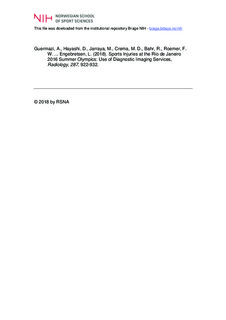| dc.contributor.author | Guermazi, Ali | |
| dc.contributor.author | Hayashi, Daichi | |
| dc.contributor.author | Jarraya, Mohamed | |
| dc.contributor.author | Crema, Michel D. | |
| dc.contributor.author | Bahr, Roald | |
| dc.contributor.author | Roemer, Frank W. | |
| dc.contributor.author | Grangeiro, Joao | |
| dc.contributor.author | Budgett, Richard | |
| dc.contributor.author | Soligard, Torbjørn | |
| dc.contributor.author | Domingues, Romulo | |
| dc.contributor.author | Skaf, Abdalla | |
| dc.contributor.author | Engebretsen, Lars | |
| dc.date.accessioned | 2018-10-25T06:54:59Z | |
| dc.date.available | 2018-10-25T06:54:59Z | |
| dc.date.created | 2018-07-05T11:28:29Z | |
| dc.date.issued | 2018 | |
| dc.identifier.citation | Radiology. 2018, 287, 922-932. | nb_NO |
| dc.identifier.issn | 0033-8419 | |
| dc.identifier.uri | http://hdl.handle.net/11250/2569413 | |
| dc.description.abstract | Purpose: To describe the occurrence of imaging-depicted sports-related stress injuries, fractures, and muscle and tendon disorders during the 2016 Summer Olympic Games in Rio de Janeiro, Brazil. Materials and Methods: Data on radiologic examinations were collected and retrospectively analyzed centrally by two board-certified musculoskeletal radiologists (with a third musculoskeletal radiologist acting as an adjudicator in case of discrepancies). Descriptive data on all imaging examinations by using radiography, ultrasonography (US), and magnetic resonance (MR) imaging were collected and analyzed according to imaging modality, country of origin of the athletes, type of sport, and type and location of injury. Results: There were 1101 injuries that occurred in 11 274 (9.8%) athletes. A total of 1015 radiologic examinations were performed, including 304 (30.0%) radiographic, 104 (10.2%) US, and 607 (59.8%) MR examinations. Excluding 10 athletes categorized as refugees, athletes from Africa had the highest utilization rate (14.8%, 148 of 1001). Athletes from Europe underwent the most examinations with 103 radiographic, 39 US, and 254 MR examinations. Gymnastics (artistic) had the highest percentage of athletes who underwent imaging (15.5%, 30 of 194). Athletics (track and field) had the most examinations (293, including 53 radiographic, 50 US, and 190 MR examinations). Conclusion: The overall occurrence of imaging used to help diagnose sports-related injuries at the Rio de Janeiro 2016 Summer Olympics was 6.4% of athletes. In these cases, MR imaging comprised 60% of imaging utilization. | nb_NO |
| dc.language.iso | eng | nb_NO |
| dc.subject | athletic injuries / diagnostic imaging* | |
| dc.subject | Brazil | |
| dc.subject | cumulative trauma disorders / diagnostic imaging* | |
| dc.subject | diagnostic imaging / methods* | |
| dc.subject | female | |
| dc.subject | fractures, bone / diagnostic imaging* | |
| dc.subject | humans | |
| dc.subject | magnetic resonance imaging | |
| dc.subject | male | |
| dc.subject | muscular diseases / diagnostic imaging* | |
| dc.subject | radiography | |
| dc.subject | retrospective studies | |
| dc.subject | tendon injuries / diagnostic imaging* | |
| dc.subject | ultrasonography | |
| dc.title | Sports Injuries at the Rio de Janeiro 2016 Summer Olympics: Use of Diagnostic Imaging Services | nb_NO |
| dc.title.alternative | Sports Injuries at the Rio de Janeiro 2016 Summer Olympics: Use of Diagnostic Imaging Services | nb_NO |
| dc.type | Journal article | nb_NO |
| dc.type | Peer reviewed | nb_NO |
| dc.rights.holder | © 2018 by RSNA | |
| dc.source.pagenumber | 922-932 | nb_NO |
| dc.source.volume | 287 | nb_NO |
| dc.source.journal | Radiology | nb_NO |
| dc.source.issue | 3 | nb_NO |
| dc.identifier.doi | 10.1148/radiol.2018171510 | |
| dc.identifier.cristin | 1595851 | |
| dc.description.localcode | Seksjon for idrettsmedisinske fag / Department of Sports Medicine | nb_NO |
| cristin.unitcode | 150,34,0,0 | |
| cristin.unitname | Seksjon for idrettsmedisinske fag | |
| cristin.ispublished | true | |
| cristin.qualitycode | 2 | |
